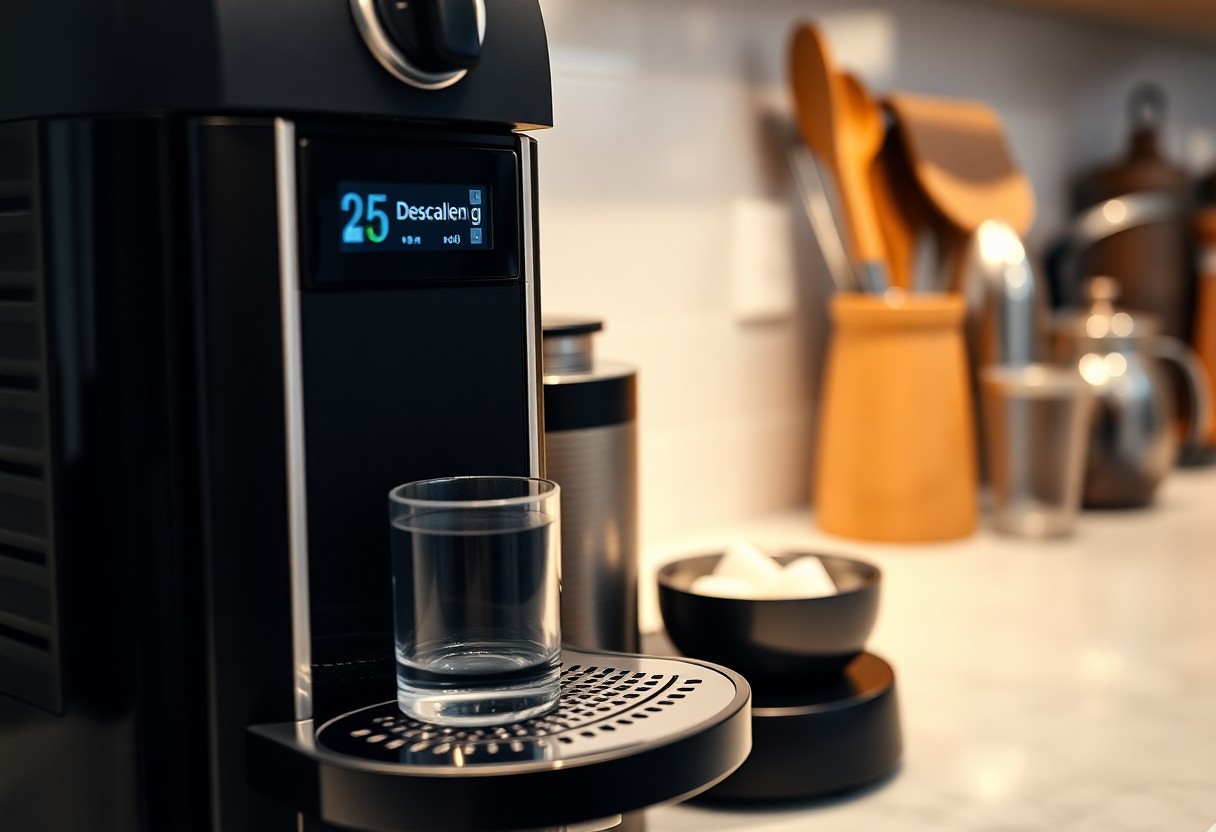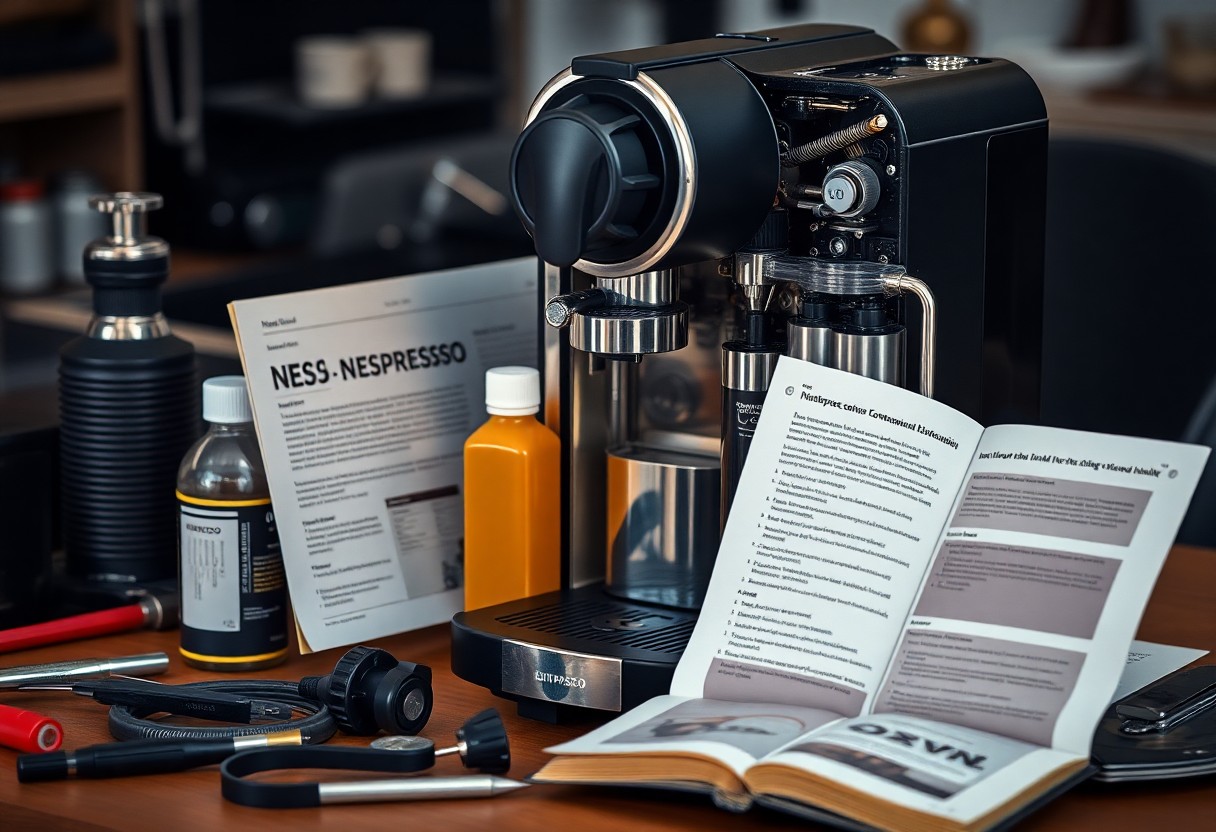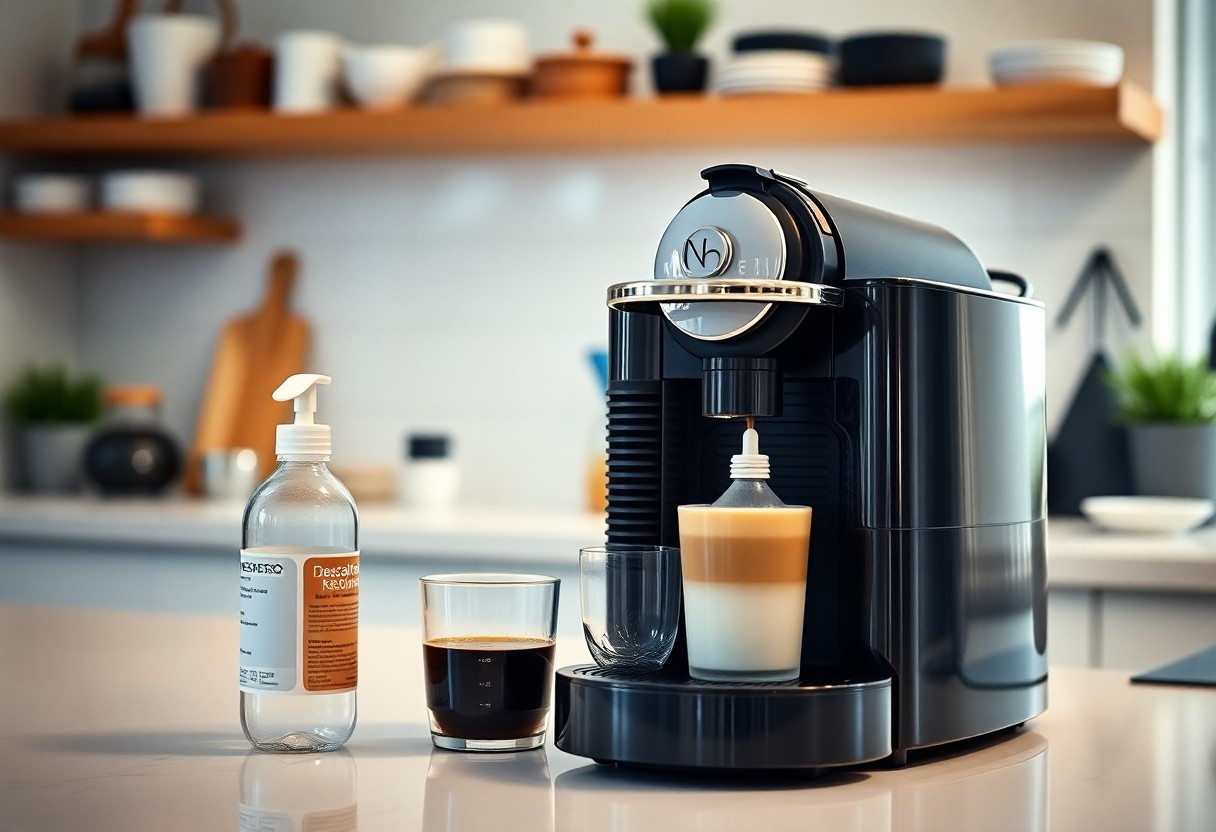How to Descale a Nespresso Coffee Machine – Maintenance Guide
You can ensure your Nespresso coffee machine brews delicious coffee by performing regular descaling. This important maintenance task prevents mineral buildup that can clog your machine and affect the flavor of your coffee. In this guide, we will walk you through the step-by-step process to effectively descale your Nespresso machine, using the right products and techniques to optimize performance and extend its lifespan. By dedicating a little time to this maintenance, you’ll be able to enjoy consistently great coffee every time.
Key Takeaways:
- Descaling is important to maintain optimal performance and extend the lifespan of your Nespresso coffee machine.
- Use a Nespresso-approved descaling solution for effective results, as other products may damage the machine.
- Follow the specific descaling instructions for your machine model to ensure proper procedure and results.
- Plan to descale your machine every 3-6 months, or more frequently if your water is hard.
- Regular maintenance, including cleaning the water tank and capsule container, enhances the overall coffee brewing experience.

The Importance of Descaling Your Nespresso
Descaling your Nespresso coffee machine is imperative for ensuring optimal performance and longevity. Regular maintenance prevents mineral buildup, which can lead to poor coffee quality and machine damage. For detailed instructions on How to Clean and Descale a Nespresso Machine, adhering to this task can significantly elevate your brewing experience and save you from costly repairs in the future.
The Impact of Limescale on Performance
Limescale accumulation in your Nespresso can dramatically hinder its functionality. This mineral deposit can obstruct water flow, leading to uneven heating and compromised extraction. As a result, your once rich and flavorful coffee may turn into a insipid brew, robbing you of the full sensory experience that quality coffee offers.
Health Implications of Neglecting Maintenance
A poorly maintained coffee machine can contribute to health risks by fostering bacteria growth within the unit. When you skip descaling, mineral buildup creates an optimal environment for harmful microorganisms. These bacteria might then leach into your coffee, exposing you and your loved ones to potential health hazards that could easily be avoided with regular maintenance.
Gathering Your Tools: Essentials for Effective Descaling
To effectively descale your Nespresso coffee machine, gather a few crucial tools. Start with a quality descaling solution, which is key to breaking down mineral buildup. You’ll also need a large container to catch the descaling liquid that flows through the machine, ensuring no mess on your countertop. For further details on maintaining your machine, check out How to Clean & Descale Your Coffee Machine. Having everything prepared will make the descaling process smooth and efficient.
Descaling Solution Options: Store-Bought vs. DIY
Choosing a descaling solution can impact the efficiency of the process. Store-bought solutions are specifically formulated for your Nespresso machine and often yield the best results. However, a simple DIY alternative can consist of equal parts water and white vinegar, providing a more natural descaling solution if you’re looking for a budget-friendly option. Just ensure that whatever solution you choose is safe for use with your specific model.
Necessary Accessories: What You’ll Need Before You Start
Before you initiate the descaling process, ensure you have the necessary accessories. First, a large bowl or container is crucial for collecting the output during the descaling cycle. Additionally, you may want to have a measuring cup on hand for precise mixing of your descaling solution. A clean cloth or sponge is helpful for wiping down any spills and cleaning the machine exterior. Having these items readily available streamlines the process and minimizes frustration.
Make sure you have a good-sized bowl or container that can hold at least 1 liter of liquid, as that’s usually the amount your machine will expel during the descaling cycle. Check if you have a measuring cup at home to accurately mix your descaling solution. A cloth or sponge helps in cleaning up any potential spills and keeping your machine looking pristine. Organizing these accessories beforehand will help you avoid interruptions and allow for a more efficient descaling session.
Step-by-Step Descaling Process: Ensuring Optimal Functionality
| Step | Description |
| 1 | Prepare your machine by removing the capsule holder and drip tray. |
| 2 | Mix the descaling solution with water as per instructions on the product. |
| 3 | Pour the solution into the water reservoir. |
| 4 | Activate the descaling mode on your Nespresso machine. |
| 5 | Run the machine to cycle the descaler through it. |
| 6 | Rinse the water reservoir, refill with fresh water, and run a flushing cycle. |
Preparing Your Machine: Initial Set-Up
Prior to starting the descaling process, you need to prepare your Nespresso machine effectively. Begin by ensuring that the machine is turned off and unplugged. Remove the capsule holder and drip tray, thoroughly cleaning these components if necessary. Additionally, place a large container underneath the coffee outlet to collect the descaling solution as it flows through the system. This pre-setup sets the stage for efficient descaling.
The Actual Descaling Procedure: A Foolproof Guide
This procedure ensures that your coffee machine gets a thorough cleaning. Begin by mixing your chosen descaling solution with water in the water reservoir according to the manufacturer’s instructions. Once the solution is ready, place the reservoir back in the machine and activate the descaling mode. The solution will flow through the internal components, flushing out limescale deposits. After the process, rinse the reservoir, refill it with fresh water, and run a flushing cycle to eliminate any remaining descaler residue.
The descaling process will vary slightly depending on the specific model you have, so consult your user manual for any unique steps. Typically, Nespresso machines feature an intuitive interface with clear instructions for initiating descaling mode. Take note of how long the process takes—about 20-30 minutes—and be mindful to watch for any alerts indicating the completion of the cycle. Completing this procedure regularly could significantly enhance your machine’s performance, ensuring your coffee always tastes fresh and flavorful.

Troubleshooting Common Descaling Dilemmas
During the descaling process, you might encounter several challenges that can hinder your efforts. Issues such as erratic water flow, machine errors, or persistent limescale can arise, leaving you uncertain. A good understanding of these challenges will help you tackle them effectively, ensuring your coffee machine remains in peak condition. Identifying these hitches early can save you time and prevent potential damage.
Identifying Red Flags During the Process
Watch out for unusual sounds or water leaks during descaling. If your Nespresso machine is making strange noises, it could indicate blockages or internal issues. Additionally, if water isn’t flowing evenly or is pooling, it may signal limescale buildup affects the system. Keeping an eye out for these signs is key to maintaining your machine’s health.
Solutions for Stubborn Limescale Build-Up
For persistent limescale problems, solutions can include a second round of descaling or using a vinegar solution alongside your descaling agent. Sometimes, utilizing a more potent descaling product specifically designed to tackle severe limescale can do the trick. If the standard methods fail to clear the buildup, opting for a dedicated limescale remover can restore your machine’s performance in no time.
In cases of extreme limescale accumulation, consider a specialized descaling solution that is more effective than the standard options. Brands such as Urnex or DeLonghi offer products that target tough limescale specifically. Additionally, applying the solution more than once, and allowing it to sit for a longer duration, may give it a chance to break down stubborn deposits. Always follow the manufacturer’s instructions on dilution and application for best results.
Best Practices for Routine Maintenance and Longevity
Routine maintenance extends the lifespan of your Nespresso coffee machine and ensures optimal performance. Regularly inspect and clean various components, including the water reservoir and drip tray, to prevent buildups that could impact flavor or functionality. Consistently using filtered or bottled water can help minimize limescale accumulation and improve the overall taste of your coffee, allowing you to enjoy each brew fully.
Frequency of Descaling: Tailoring to Your Usage
The frequency of descaling hinges on your coffee habits. If you’re a daily coffee drinker, descaling every three months will help keep your unit in prime condition. For moderate users, consider a schedule of four to six months, adjusting as needed depending on your local water hardness. Observing any changes in brewing performance can help you fine-tune your descaling routine.
Additional Maintenance Tips for Peak Performance
To keep your Nespresso machine running smoothly, regular maintenance touches beyond descaling can make all the difference. Occasionally clean the machine’s exterior with a soft, damp cloth to remove dust and spills. Ensure that the coffee spouts are free from coffee oils and residues by wiping them down. Take time to check the water reservoir for any signs of mold or buildup, as clean water is necessary for optimal flavor and functionality.
- Keep the exterior clean to maintain visual appeal and prevent corrosion.
- Wipe down coffee spouts regularly to prevent residue from affecting flavor.
- Inspect the water reservoir to avoid bacterial build-ups that could taint brews.
- After maintaining these routines, your machine will provide consistent quality coffee for years.
Regular inspections and cleaning will ensure all elements of your Nespresso machine work harmoniously. Invest in a soft brush to reach into crevices, where coffee grounds love to hide. If your machine uses a drip tray, empty it frequently to avoid overflow and potential spills. Clean these components regularly with gentle soapy water to ensure they serve their purpose without adding unwanted flavors to your coffees.
- Utilize a soft brush for hard-to-reach areas to prevent blockages.
- Ensure the drip tray is emptied often to avoid spills and mess.
- Wash internal parts with soapy water to maintain pristine conditions.
- After incorporating these tips, you maximize your Nespresso’s longevity and flavor quality.
Final Words
With these considerations, you can effectively descale your Nespresso coffee machine to ensure optimal performance and longevity. By following the maintenance guide, you’ll keep your machine free of mineral buildup, resulting in a better tasting coffee. Regular descaling not only enhances the flavor but also protects your investment, allowing you to enjoy your favorite brews for years to come. Make this simple process a part of your routine and savor the full potential of your coffee experience.
FAQ
Q: Why is it important to descale my Nespresso coffee machine?
A: Descaling your Nespresso coffee machine is important for maintaining its performance and longevity. Over time, mineral buildup from water can clog the machine’s components, leading to reduced water flow, poor coffee flavor, and potentially damaging the machine. Regular descaling helps ensure your coffee maker operates efficiently and delivers the best-tasting coffee.
Q: How often should I descale my Nespresso coffee machine?
A: It is recommended to descale your Nespresso machine every 3 months, or after preparing approximately 300 coffee servings. However, if you live in an area with hard water, you might need to descale more frequently to prevent mineral buildup. Always check the manufacturer’s guidelines for specific recommendations based on your model.
Q: What products can I use for descaling my Nespresso coffee machine?
A: The best option for descaling your Nespresso machine is to use a descaling solution specifically designed for coffee machines, such as the official Nespresso descaling liquid. This product effectively removes limescale without damaging the internal components. Some users might also choose to use a mixture of equal parts water and vinegar, but this method is less recommended as it can cause lingering odors and may not be as effective as commercial solutions.
Q: What is the step-by-step process for descaling a Nespresso coffee machine?
A: To descale your Nespresso machine, follow these steps:
1. Empty the water tank and capsule container.
2. Fill the water tank with the descaling solution mixed with water according to the product instructions.
3. Place a container (with at least 1 liter capacity) under the coffee outlet.
4. Turn on the machine and select the descaling program if available (refer to your machine’s manual). If not, manually brew the water through the machine until the water tank is empty.
5. Rinse the water tank thoroughly and fill it with clean water.
6. Run several cycles of clean water through the machine to remove any residual descaling solution.
7. Once completed, clean the drip tray and enjoy your freshly descaled machine!
Q: What signs indicate that my Nespresso coffee machine needs descaling?
A: Several signs can indicate it’s time to descale your Nespresso machine. These include a decrease in coffee flow or pressure, a longer brewing time, an unusual taste in your coffee, and the presence of a calcium build-up or visible white residue in the water tank. Additionally, many Nespresso machines have a warning light that illuminates when it’s time to descale, making it easy to stay on top of maintenance.







